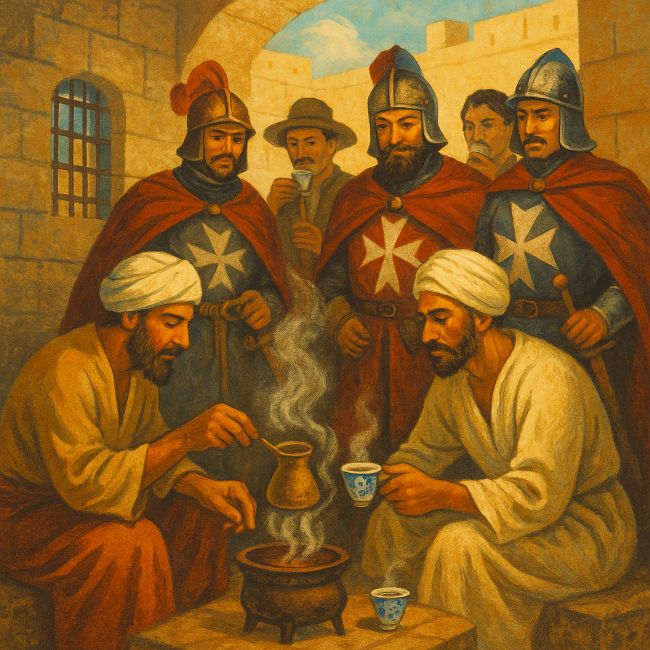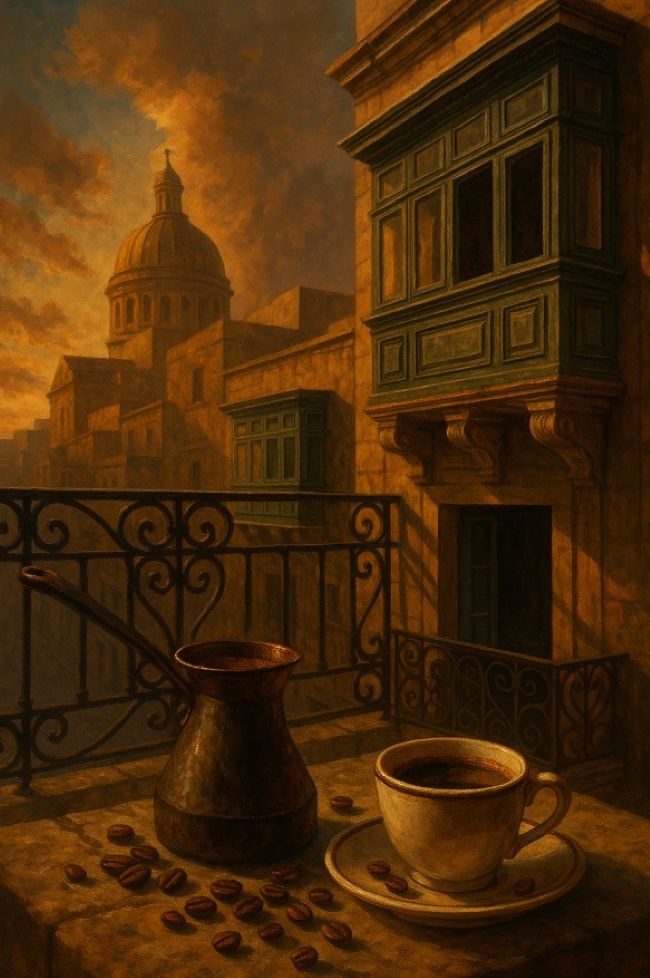| Malta Short Let: Cozy Stay in Gzira | |
|
Sliema Area Modern Designer Finished 2 Bedrooms + Games Room. First floor with Maltese Balcony Large back Terrace with swinging sofa Fully Airconditioned + Full Kitchen 3 TVs, including 65” with backlight. |
 |
|
Book Now: Google Travel | Direct (Cheapest) | Booking.com | Airbnb |
|
Malta, a sun-scorched speck in the Mediterranean, isn’t just famous for its knights and fortifications—it’s where coffee, that dark elixir of the “infidels,” staged a quiet rebellion. Why Is Malta Important? Long before Europe’s aristocrats sipped it in gilded salons, Malta’s Muslim slaves were brewing it in a dank prison, turning captivity into a caffeine-fueled cultural coup. From a gritty prison brew to a knightly obsession, coffee’s Maltese tale is one of grit, gritiness, and a surprising dash of glamour.
The Prison That Percolated a Revolution
Picture this: Valletta, 1633. Inquisitor Martino Alfieri, a man more accustomed to hunting heretics than herbed drinks, scribbles a furious order: track down a slave caught in a shadowy shop within the slaves’ prison. The crime? Serving up a mysterious “herb vulgo dicta café”—coffee, already a buzzword among the locals. As Alfieri put it, this was a place “ubi Infideles solent bibere” (where Muslims regularly go to drink), and it wasn’t just slaves indulging. This wasn’t some quaint café with velvet curtains—it was a gritty corner of a prison, where Ottoman captives turned coffee into a lifeline, a taste of home amid chains. The prison, part of the Three Cities, was a hub of activity, with slaves even running small businesses.
But here’s the twist: the Maltese couldn’t resist. Working-class folk, knights, and even posh travelers on the Grand Tour flocked to this unlikely hotspot. In 1663, Baron Georg Friedrich zu Eulnberg, a German noble with a taste for the exotic, strutted in with knights in tow to watch a slave grind and brew. He sipped, he savored, and Malta’s coffee craze notched up a rank. The slaves’ prison wasn’t just a jail—it was Malta’s first coffeehouse, a rough-and-tumble precursor to Europe’s refined salons.
A Scholar, a Brew, and a Dash of Spice
By 1671, coffee wasn’t just a slave’s secret—it was a Maltese obsession. Enter Domenico Magri, a priest with a pen sharper than a corsair’s blade. In his snappily titled Virtu del Kafè, he declared coffee “molto praticata in questa mia Patria” (widely practiced in my country), a drink so common in Malta that it baffled Italy, where it was still a novelty. Magri wasn’t shy about jazzing it up either—boil it with sugar and a pinch of coriander, he advised, and wait an Apostles’ Creed for the grit to settle. Health perks? Sure, it cured headaches and spruced up ladies’ looks—though he kept mum on how. Coffee goes well with some Maltese traditional Pastizzi
Magri’s pamphlet, complete with a coffee bean doodle for the uninitiated, wasn’t just a recipe book—it was proof Malta was ahead of the caffeine curve. While Europe debated coffee’s morals, Maltese tongues were already tingling with its bitter bite.
Dive deeper into Malta’s ancient roots at The Heartbeat of Ancient Malta.
Coffee Shops: From Prison to Piazza
Fast forward to 1784, and Malta’s harbor towns were buzzing with 52 licensed coffee shops—25 in Valletta alone, one for every 700 souls in a city tighter than a corsair’s knot. Places like Café de la Reine (later Café Premier) and Café Cordina became the beating heart of social life in Valletta, where knights rubbed elbows with merchants over steaming cups.
Travelers couldn’t miss them—Norwegian priest Pavels and sculptor Bertel Thorvaldsen docked in 1796 and quipped, “the coffee-houses in Valletta are easy to find.”
Plan your own visit with Malta Travel Guide.
But it wasn’t all rough brews anymore. Dig into Valletta’s dirt, and you’ll find Kutahya coffee cup fragments—delicate Turkish fritware that screams sophistication. At the Inquisitor’s Palace, they unearthed coffeepots, grinders, and a cuccumella, a Neapolitan gizmo that filtered out the sludge. Coffee wasn’t just a drink now—it was a status symbol, a far cry from its prison roots. Explore more hidden gems at Mdina’s Lesser-Known Gems.

The Taste of Grit and Glory
Not everyone was sold on coffee’s charms. English traveler George Sandys griped it “does not taste better than soot: burnt, bitter and gritty.” Fair enough—early Maltese coffee was a gut-punch, dark as ink and thick with grounds. But for the working class, that was the appeal. It mirrored their coarse bread, a cheap belly-filler in a hungry town.
Slaves sold it dirt-cheap, stigma and all, making it the people’s brew. Learn about Malta’s economic resilience in The Island Economy Paradox.
The elite, though, had other ideas. Grand Master Emanuel de Rohan, dubbed a “coffee addict” by traveler De Bray, kept a garzone di cafè (coffee maker) on staff and stocked his palace with beans, reflecting the Knights’ economic prowess.
By 1748, knights were whipping up coffee sorbets and biscotti, turning the infidel’s drink into a knightly delicacy. Coffee’s journey from a slave’s brew to a knightly treat mirrors Malta’s knack for turning grit into glory.
Coffee’s Maltese Legacy
Today, Malta’s coffee scene is a mashup of old and new. Traditional kafè msajjar—spiked with chicory, cloves, and aniseed—sits alongside frothy cappuccinos at haunts like Caffe Cordina. From a slave’s prison pot to a globalized grind, coffee’s Maltese saga is a brew of resilience, rebellion, and a knack for making the foreign feel like home.
Planning a trip? Check out Holidays in Mediterranean Islands or unwind at Golden Bay Malta. For history buffs, The Great Siege of Malta offers context. Enjoy Malta’s beaches with Map of Beaches in Malta, or explore its maritime heritage at Traditional Boats of Malta. Modern travelers can dive into Malta Digital Nomad, Self-Guided Tour Malta, Airbnb in Malta, or Best Things to Do in Malta with Kids.
Summary Table
| Period | Key Moments |
|---|---|
| 17th Century | Slaves brew coffee in prison (1633); Magri hails it as a Maltese staple (1671). |
| 18th Century | 52 coffee shops by 1784; knights sip sorbets; fancy cups unearthed. |
| Today | Kafè msajjar meets espresso in a caffeinated melting pot. |








